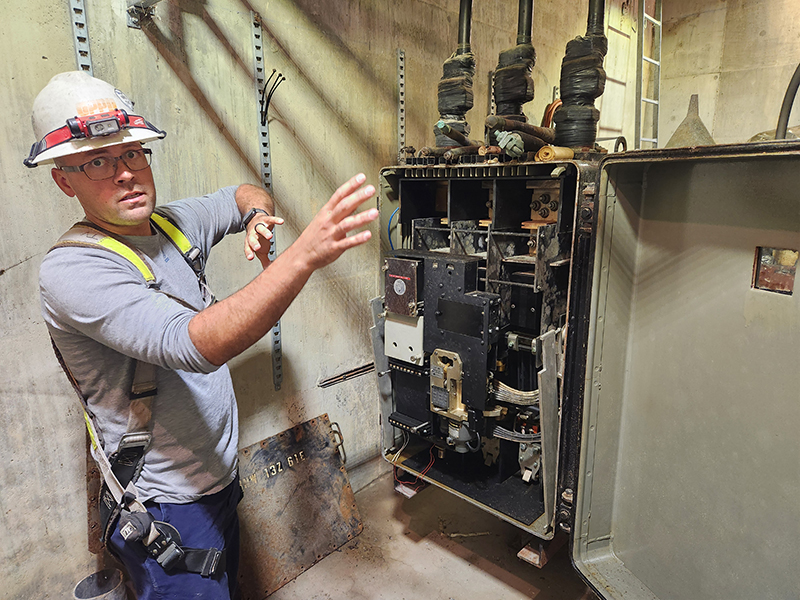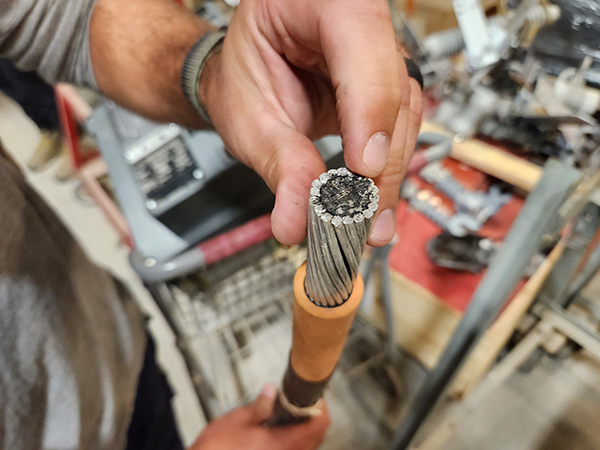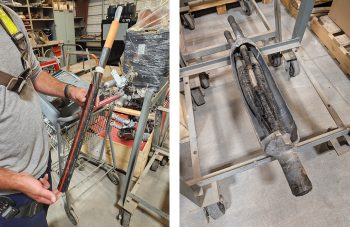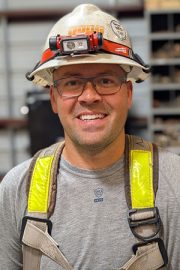Cable splicers use technical skills in tight quarters to ensure reliable power

Beneath downtown Omaha and many other areas is a vast, elaborate network of vaults and manholes.
For more than a century, electrical cables throughout the system have powered homes, businesses, hospitals and critical government buildings, even as OPPD’s grid became busier and more complex.
Maintaining it all are cable splicers, a select, 19-member team that installs, connects and repairs high-voltage underground cables to ensure reliable power.
The job is tough and technical, and it demands teamwork and safety. Because of the critical nature of the work, often a splicer team’s work cannot stop until a job is done – even if it takes 26 hours.
“There are times when it’s 2 in the morning and you’ll see that the guy you’re working with is struggling and getting tired,” said Matt Liston, an OPPD cable splicer since 2019. “That’s when you tell him to go take a break, and you take over to finish up for him. That’s how it is. We’re helping each other out the whole way.”
‘Pretty rewarding’

OPPD’s downtown network connects multiple circuits through more than 200 underground vaults to ensure redundant and resilient electrical service. Some equipment and cables are new. Others date as far back as 1916.
Splicers spend a lot of time in vaults but also work in substations and occasionally up on poles. When storms cause major outages, they help restore power and clear debris.
“Anytime we’re getting the lights back on and you see customers coming out hooting and hollering and telling you thanks, it’s pretty rewarding,” Liston said.
Splicers’ specialized skills have helped in other big cities. When Hurricane Sandy ransacked New York in 2012, for example, OPPD sent splicers to restore power in the deep caverns beneath the city’s financial district.
Training for the job
OPPD cable splicers start as apprentices, a challenging four-year journey with constant study and hands-on learning. Previous electrical experience helps, and many splicers are graduates of Metropolitan Community College’s utility line technician program.
Under the guidance of more experienced journeymen splicers, apprentices learn the basics of their craft: soldering, hand-taping lead joints, hammering lead sleeves into the proper shape to cover cables, and other nuanced skills.
Every cable must withstand extreme electrical, thermal and mechanical stress, and decades (sometimes a full century) of high-voltage use.
Apprentice splicers spend a lot of time in an underground practice vault at OPPD’s Omaha Service Center. Every morning, they ensure trucks are well-stocked with water and all the tools their crews will need that day.

To become a journeyman, apprentices must first pass a 200-question written exam, based on the books they’ve studied throughout their apprenticeship.
Then comes an oral test in front of the Joint Apprenticeship Training Committee (JATC), a group of seasoned cable splicers, managers, supervisors and OPPD safety employees. The JATC quizzes apprentices about real-life situations they’re likely to encounter on the job.
“You’ve got people staring at you, throwing questions at you, and they all know what they’re doing,” said Joe Hanover, a field supervisor and former cable splicer at OPPD’s Omaha Service Center. “It’s not like you can pull the wool over their eyes.”
For those who pass, there’s more to come.
“You’re always glad to get all of your books and tests done, but that’s just the beginning,” Liston said. “You’re not out of the woods yet. As a first-year journeyman, you’re going to get sent to a trouble call and you’re going to be the guy down in the hole. Young apprentices are going to look for you for answers. You’ve got your foreman to lean on a little, but you’re the one making a lot of the decisions.”
Finding and solving problems
As underground distribution networks expand and load on infrastructure increases, the demand for advanced diagnostic and testing tools has grown sharply. Sometimes, damage or wear on a cable will cause an electrical fault, sending current to areas it isn’t supposed to go.
When that happens, splicers use a specialized cable test van, a mobile laboratory that helps splicers locate faults and perform cable diagnostic testing and condition assessments. They commonly use a surge generator, often called a thumper. The thumper charges a large capacitor bank to a high direct-current voltage. When that energy reaches the cable fault, it creates a momentary electrical arc along with a loud thump in the ground above the fault.

“You just have to go down the street listening,” Liston said. “We’ve had customers call 911, saying they heard an explosion in a manhole. Then we know where it is.”
Once they find the general location, cable splicers slip into harnesses and climb down underground ladders to the vaults below.
Inside a manhole, they pull damaged cables out of their ducts and install and splice new cables back in the same place.
Following procedures

Lead cables are spliced together and taped with insulating tape and wiped with lead solder. Making a set of single joints can take anywhere from 8 to 14 hours.
“With every step, there are procedures we need to follow,” said Tyler Vaughan, an OPPD cable splicer.
Once, a major fire in a vault melted wires, scorched the inner walls and caused a large outage downtown. Crews took turns working 24-hour shifts to finish the job.
OPPD maintains a database of panoramic photos inside every underground vault and manhole downtown. The photos allow cable splicers to review how they should look ahead of time.
“The first time you get in a hole, you’re looking at everything,” Vaughan said. “You have to be aware of all the hazards that could exist. There could be damage to a cable or failed insulation. If you don’t notice things like that, you could find yourself in a ball of fire.”
Attention to detail
Hanover was in a manhole in March 2007 when he and his coworker noticed a cable stretched unusually taut against the wall. They covered it with a tarp so they could work on newer cables above it.
A few hours later, the cable faulted. Thick, blinding smoke filled the hole. The heat burned Hanover’s arms, but the tarp likely saved their lives. OPPD would later learn that the cable was stretched taut because a contractor had hit the line at another location.
“That’s why it’s important to notice even the smallest details,” Hanover said. “That cable just decided to let loose the day we happened to be in there.”
If a duct that holds cables is damaged, splicers will try to find a different one, or they’ll call OPPD’s underground construction team to create a new cable path. Sometimes, sewers get plugged and fill with water, forcing cable splicers to pump out the connected vaults. Every day presents new challenges that splicers must overcome.
“People just know if they have electricity or not,” Vaughan said. “But there’s so much more to it.”


Grant Schulte joined OPPD as a content generalist in 2022. He is a former reporter for The Associated Press, where he covered the Nebraska Legislature, state politics and other news for a global audience. He is a graduate of the University of Iowa and a proud Hawkeye. In his free time he enjoys running, reading, spending time with his wife, and all things aviation.
View all posts by Grant Schulte >







